
Water Everywhere, And Nowhere ~ India
Part VII of the Out of Eden Walk for National Geographic

The now defunct Guru Nanak Dev Thermal Power Plant in Bathinda, state of Punjab, India. There has been some claim that the power plant is not up to contemporary environment safety standards, has given birth to serious health problems, not only in Bathinda itself, but also nearby towns and villages, especially fly ash problem.
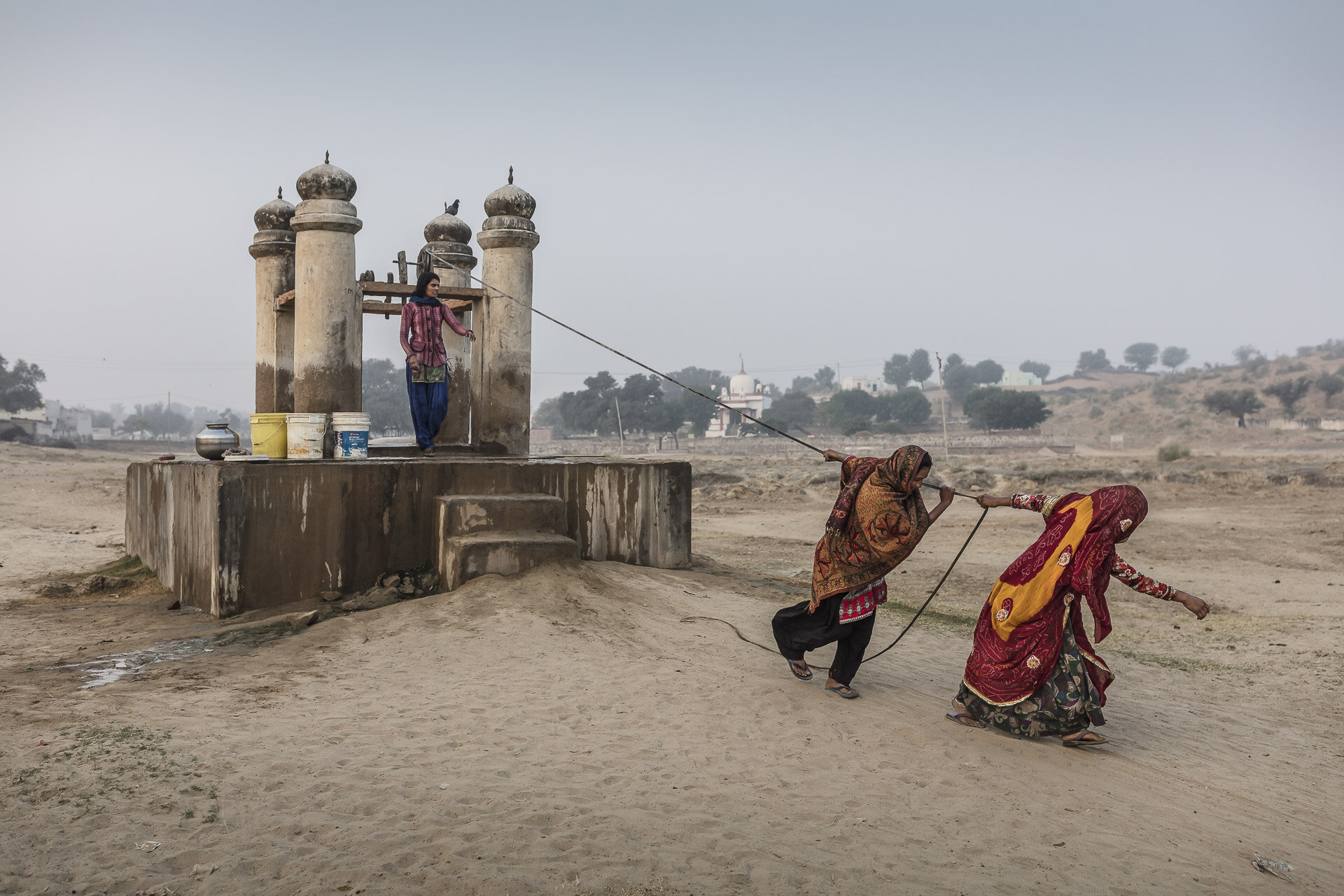
Villages from Dongra, mostly women, pull water buckets from the only well in the dry region of Rajasthan, India, yet next to the well is an ancient natural rain harvesting well, no longer used. This well, drilled years ago, is drying, soon leaving no alternative for the residents of Dongra. Water is the most acute problem in this part of India.
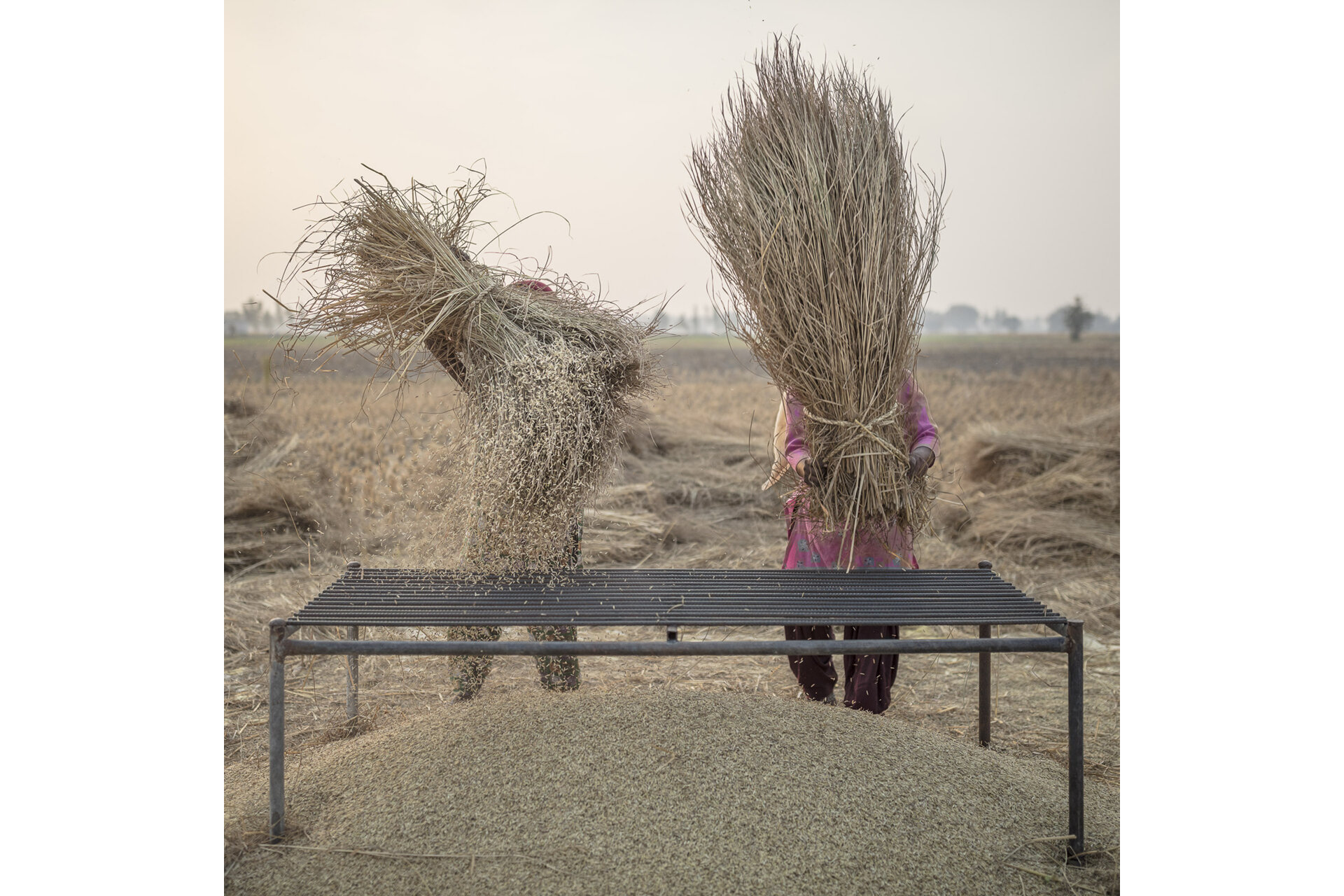
Farmers harvesting rice in Mullabherm village in Punjab in the outskirts of Amritsar. The Punjab is the agricultural heartland of India, heavily ruined by pesticides and fertilizers during the Green Revolution until today.

A darker side to the millions of sacred cows that wanted nearly every street in India, where people no longer care for them, cows scavenging for food in a concrete jungle, many consuming plastic waste, becoming sick and dying. Cows on the streets of Hisar, India, during Diwali, as candle offerings glow along sidewalks.

Young laborers from Madhya Pradesh living in a small farmhouse in Mullabherm village in Punjab outside Amritsar, India. Poverty across India drives tens of thousands of young people, even their children, to move into Punjab to work in the agriculture sector.
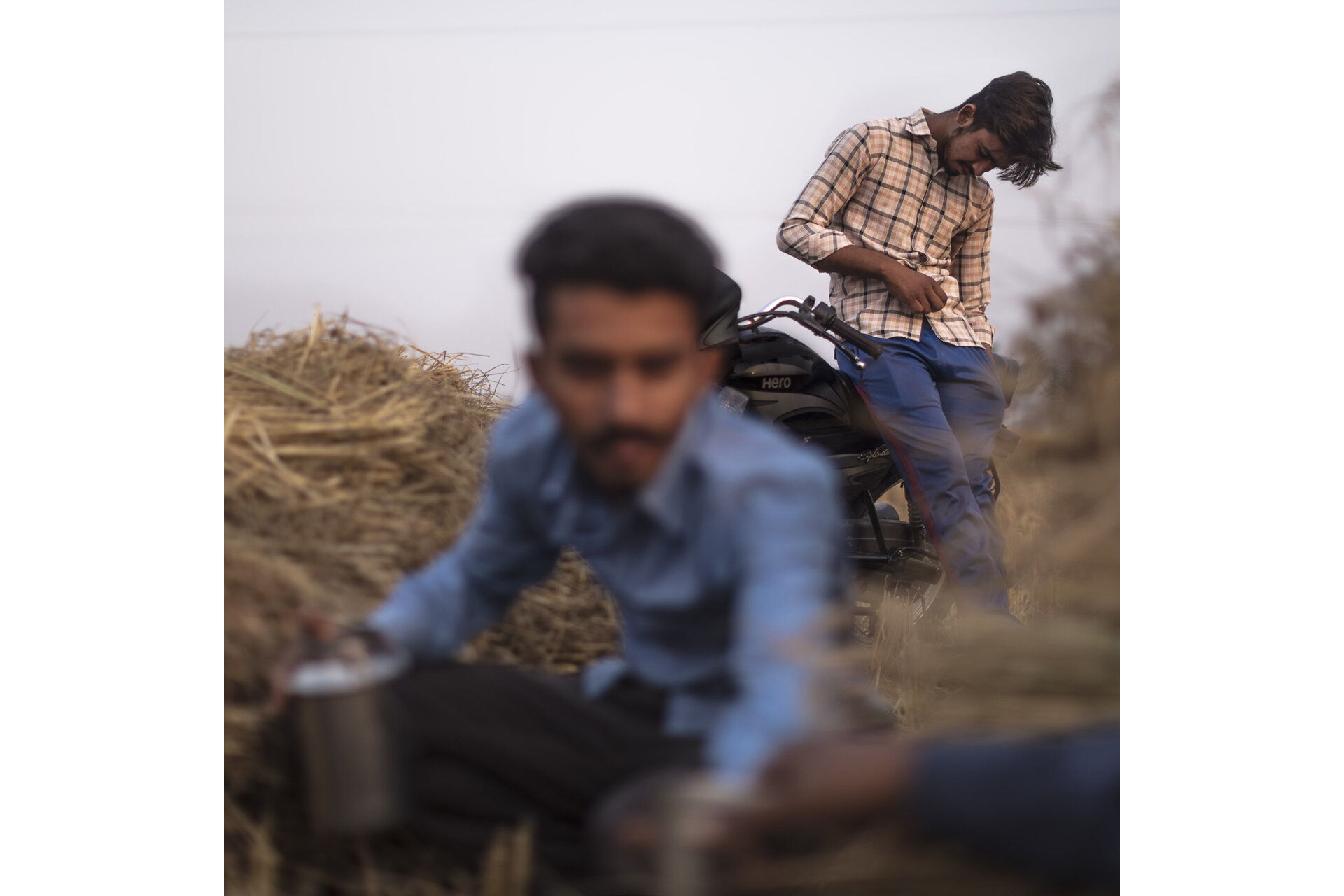
Farmers resting in Mullabherm village in Punjab in the outskirts of Amritsar. The Punjab is the agricultural heartland of India, heavily ruined by pesticides and fertilizers during the Green Revolution.

Chand Singh, in his 60’s, has severe epilepsy and can not easily move, spending much of his day layout about as he does here on the side of the road in Mari Mustafa, Punjab, India. Behind him is Jaskaran Singh, 32, spends his life in a wheelchair, born with a severe birth defect. Mari Mustafa village has the highest cancer, birth defect and other high levels of health issues in India.
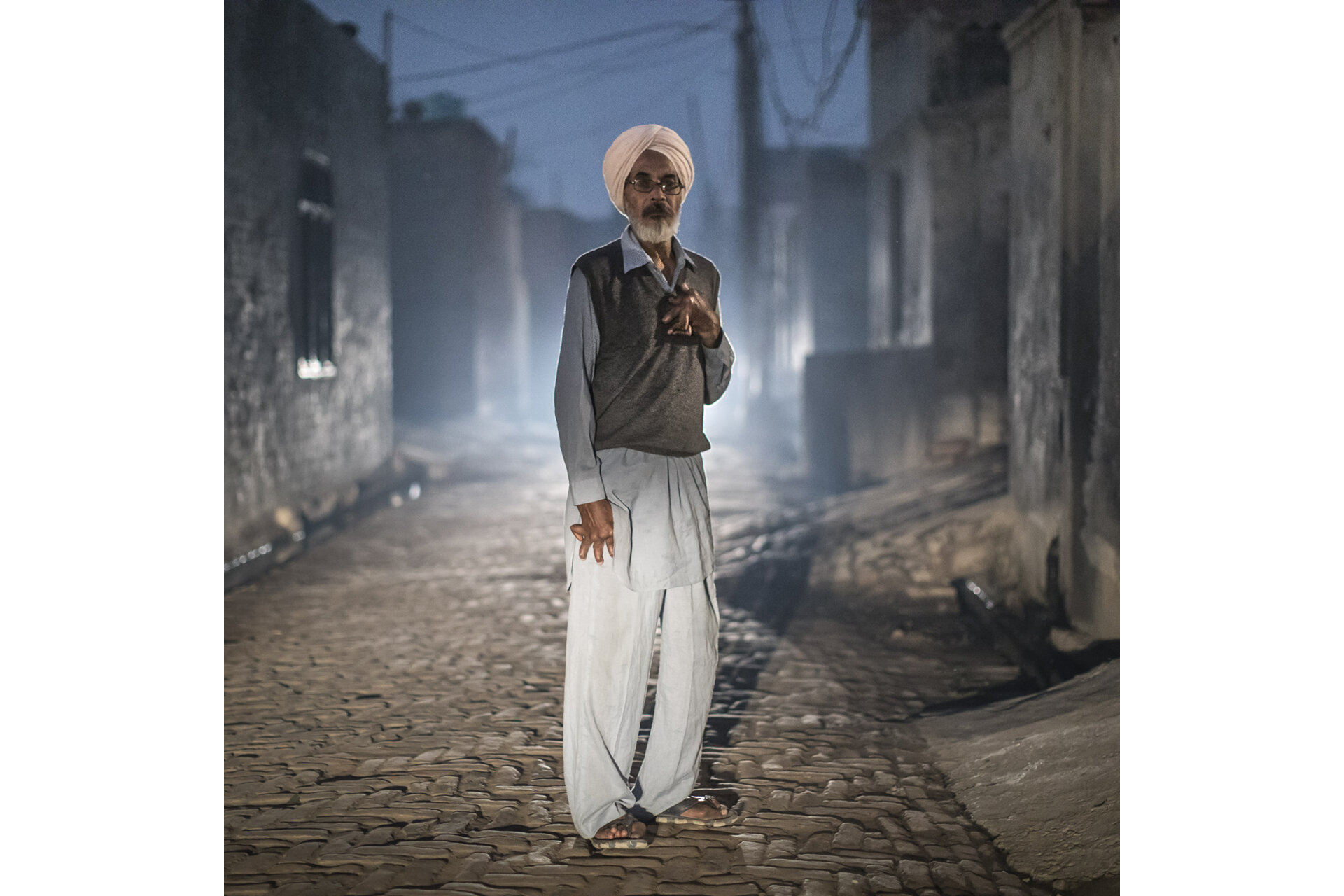
Resham Singh, 59, has extreme arthritis that began in 1994 or 24 years ago. Resham is a carpenter and drank the heavily tainted water of Mari Mustafa, Punjab, India. Doctors connect his physical deterioration from the pesticides and fertilizers used in Punjab.

Raj Singh, 55, farmer, has liver cancer and Hepatitis C, resting at his home in Mari Mustafa, Punjab, India. This village has the highest cancer rates in India.
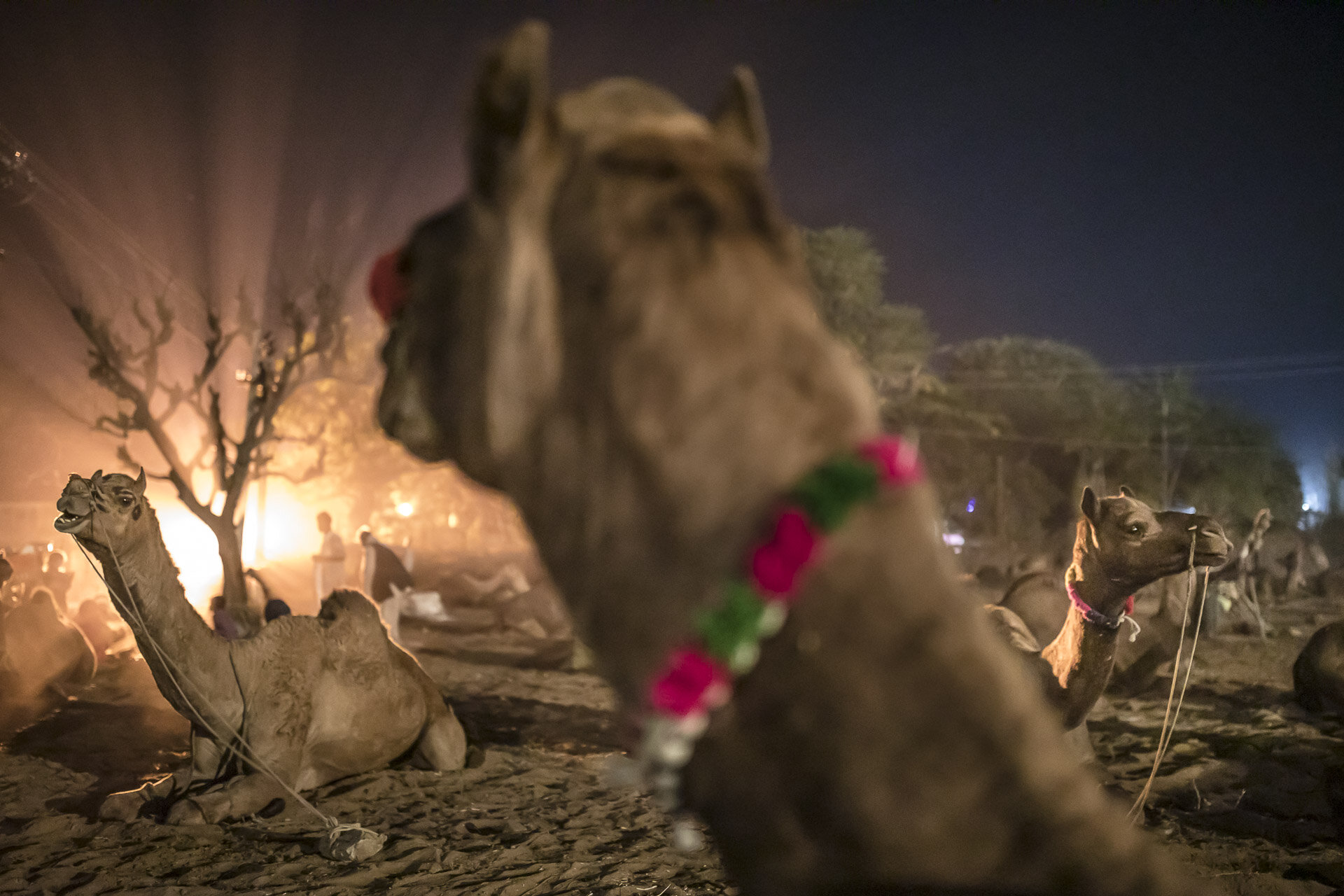
Thousands of camels and her herders at the Pushkar Camel Fair in Pushkar, Rajasthan, India, an arid part of India where water scarcity continues to affect millions,

Formerly fishermen, Sarjeet Singh, 40, and Dalveender Singh, 25, earn a basic living as boatmen who ferry supplies and people across the Beas River in Punjab, India. An orange blanket rests upon lilies to dry. Both men can no longer fish the Beas which today is filled with toxins from industrial plants along the river, decimating fish supplies and the industry.

A family waits for a train to pass along a roadway in the Punjab, India.
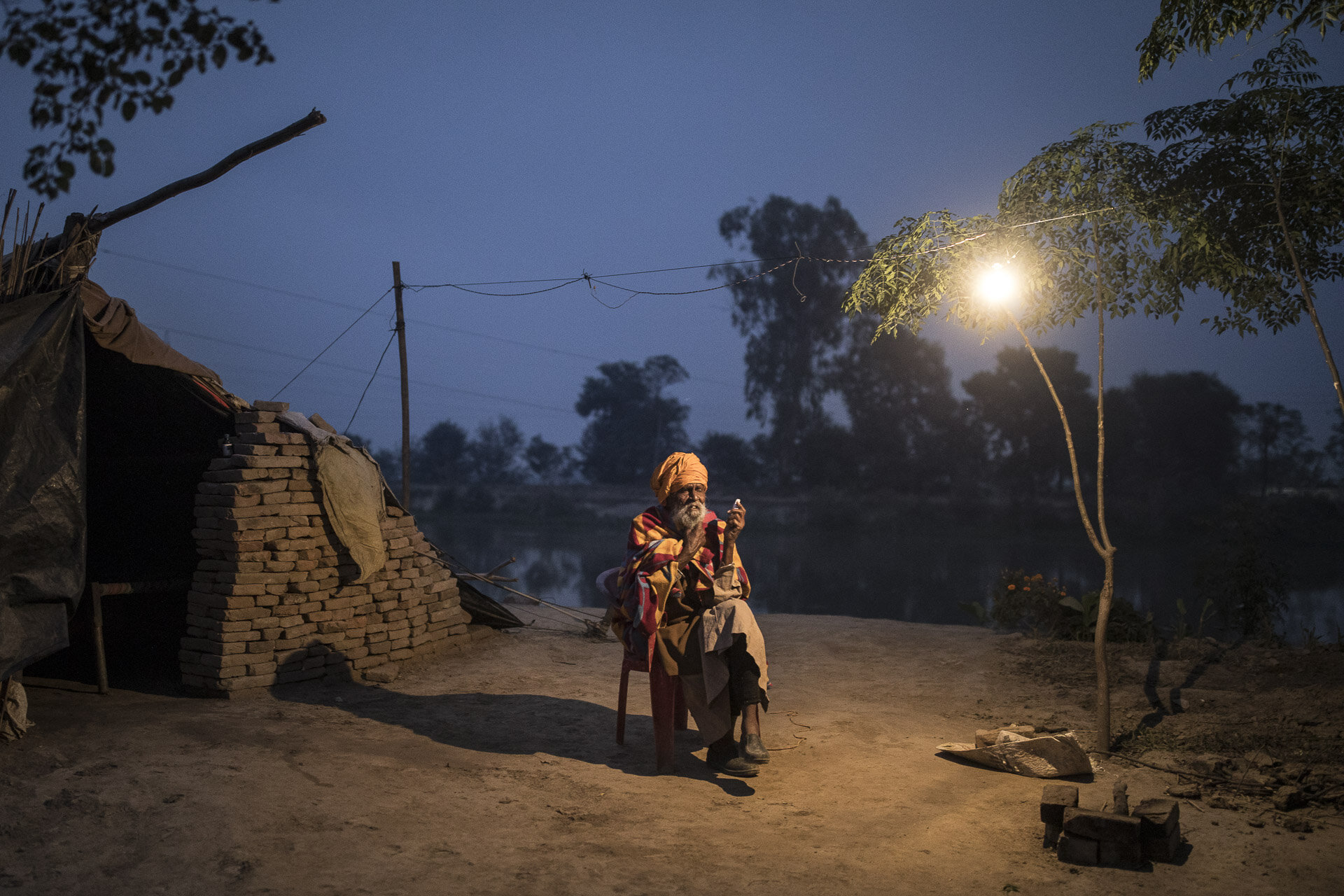
Chinda Singh, 75, who lives next to the Rajasthan Canal in Gurudithi Head Area next to the dam that regulates water from the Sutlej River. He says God made his small brick, plastic tarp-covered shack along the heavily polluted Sutlej River in Rajasthan.

Visvajaat Singh, aka, Bubbles, with his Great Dane, Boris, and Beagle, Shakira, as his 400 year old home, Fort Harasar, in Harasar, Rajasthan, India. This fort has been in his family for four centuries, a legacy of the grand era of Rajasthani royals and privilege
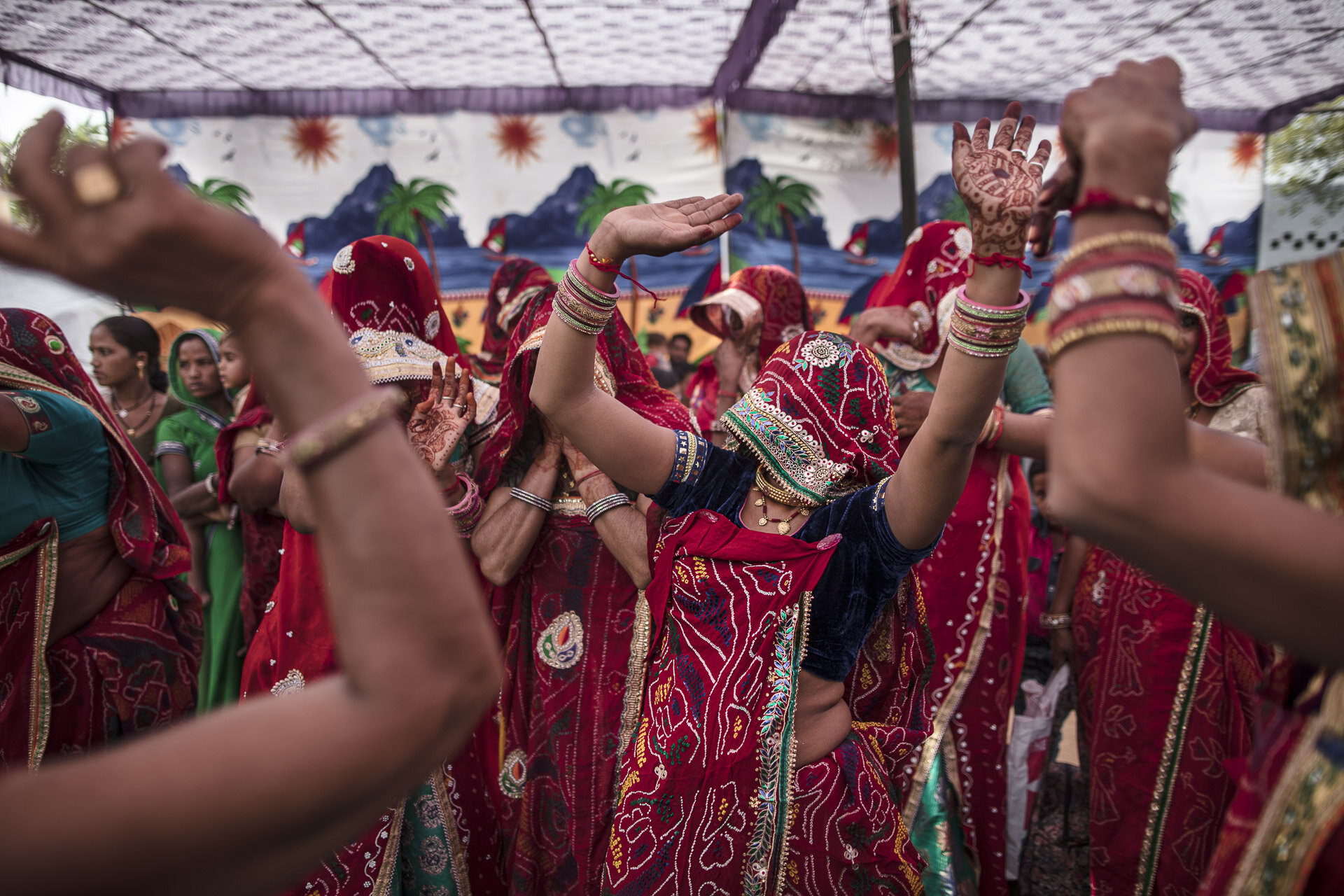
Family and friends celebrate before the wedding of, Kanchan Bajaranaya, 23, at her family's home in Harasar, Rajasthan, India. Kanchan is a success story, having access to education, she moved to Jaipur where she works in business, returning to her ancestral home in a poor rural part of Rajasthan.

Arti, 25, who lives with her three children and husband in a traditional home know as a Dhani, on the fringes of Harasar, Rajasthan, India, cooking roti at night. Those in the lower caste, such as Arti, are marginalized by the rest of the community, not able to connect to electricity or other needs such as water.

Umbrella holder during a wedding procession along the road in Rewari, Haryana, India. Matrimonial season in India, during auspicious days, brings about thousands of weddings across the country.

Ashok’s wedding was in grand style, arriving to the wedding hall on an elephant festooned in colors and dancing friends along the road in Singhana, Rajasthan, India. Matrimonial season in India, during auspicious days, brings about thousands of weddings across the country.
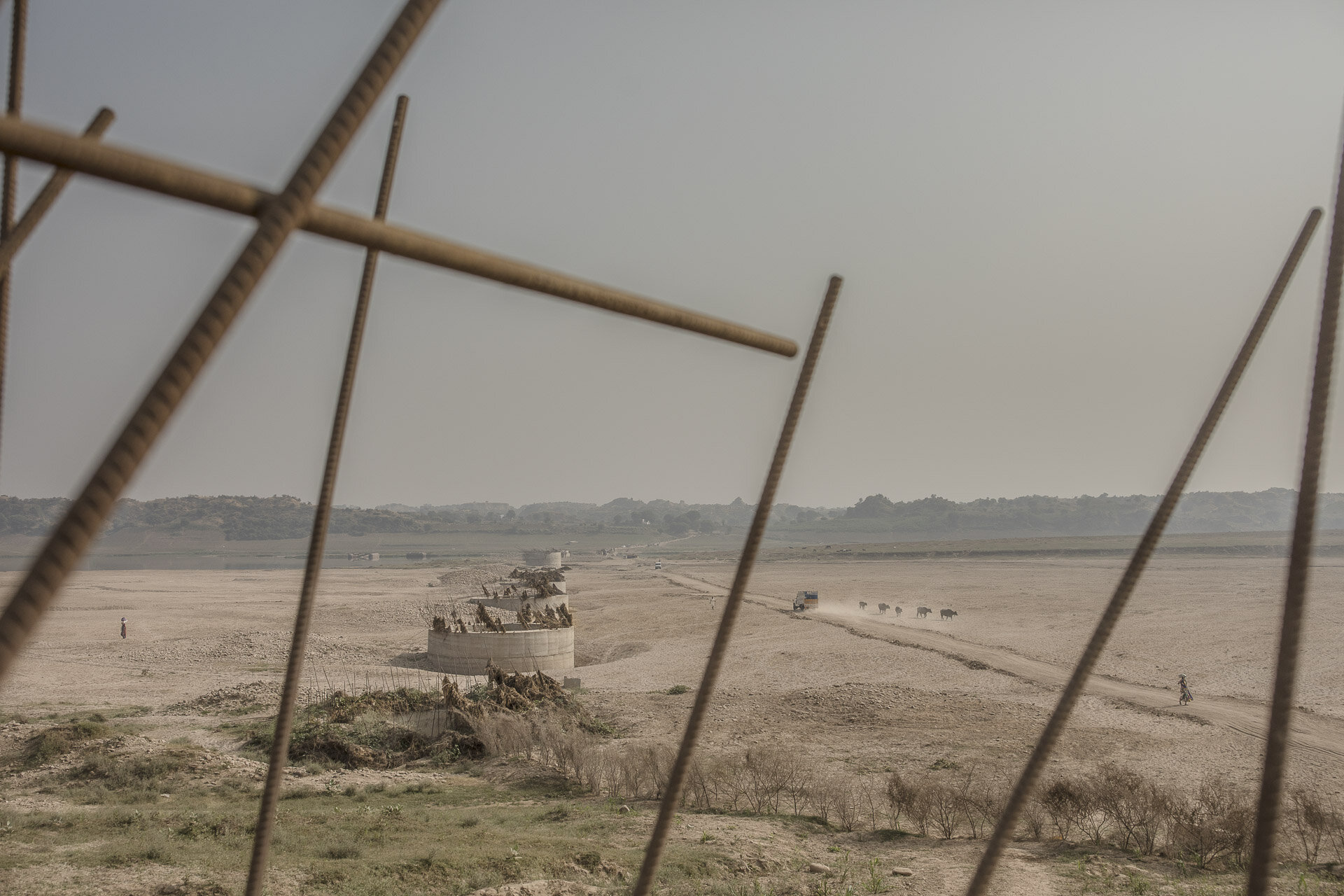
Unfinished bridge supports rusting in the Rajasthan heat, once being build to cross the Chambal River, today the crossing is still done via a floating bridge in Karauli, Rajasthan, India.

Plastics and other pollution mix with offerings of flowers in the sacred Ganges River in Varanasi (Binaris), India. The Ganges has become one of India’s most polluted rivers, sacred to all Hindus.
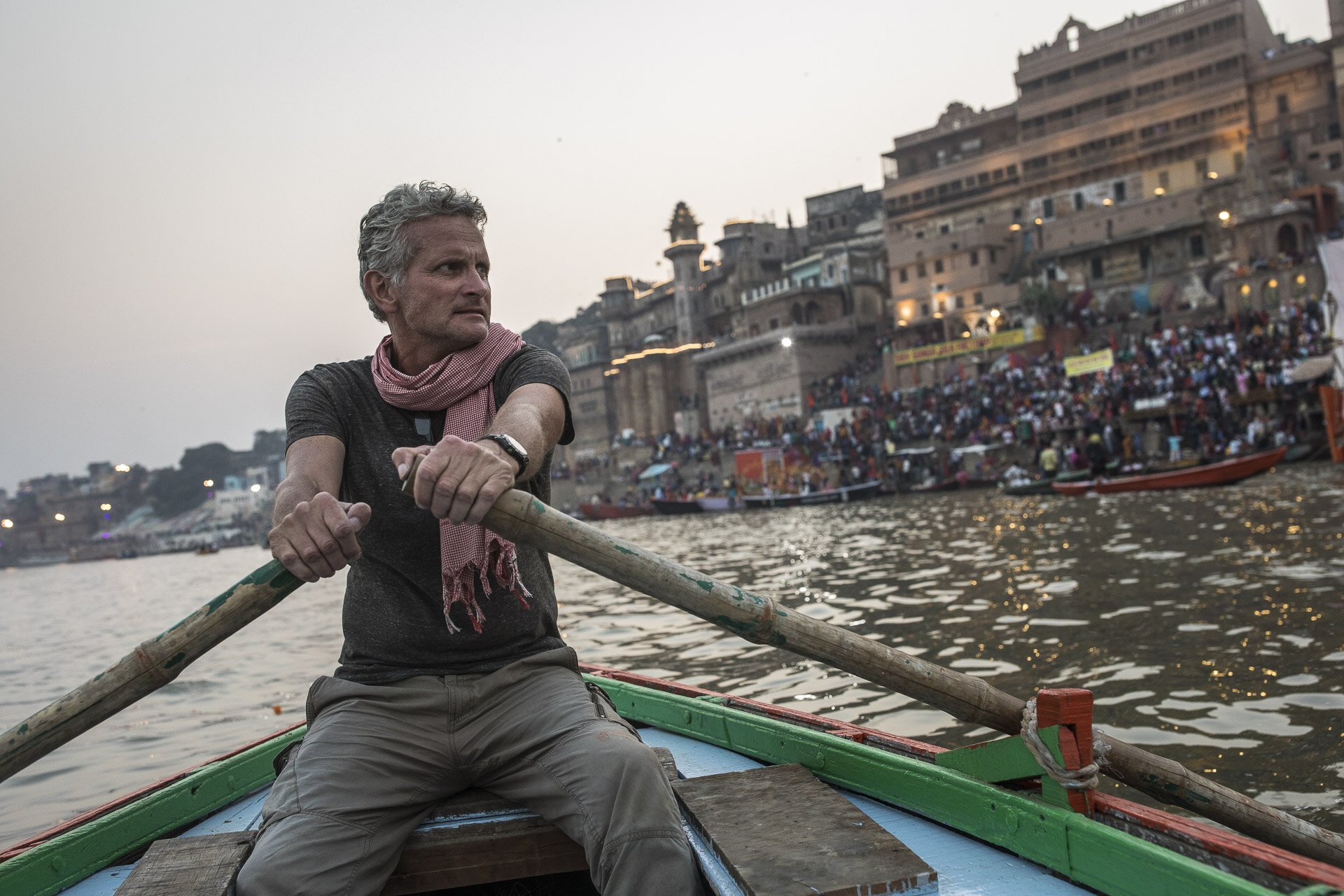
Paul Salopek rowing a boat along sacred Ganges River in Varanasi (Binaris), India. Paul, a National Geographic Fellow, is the writer and walker of the Out of Eden Walk.

Demolition of homes, many built in the 18th century, being demolished in the Vishwanath Precinct Development Project in Varanasi, to make a 43,636 sq meter open strip of land to reach the Ganges River in Varanasi, India.

Running past falling debris as demolition continues to remove much of the 18th-century building and temples, part of Vishwanath Precinct Development Project in Varanasi, to make a 43,636 sq meter open strip of land to reach the Ganges River in Varanasi, India.

Cremation of Ramesh Pandey, 36, died of brain damage at a young age, as his family prepares for his cremation along the banks of the Yamuna River near the Sangan, where the great rivers meet, in Allahabad, India. His ashes will flow at this sacred juncture into the Ganges.

After morning prayers and ablutions on a foggy morning along the Yamuna River in Prayagraj (Allahabad), India, where workers were preparing the many floating bridges that will be traversed by more than 4 million people during the 2019 Kumbh Mela in Prayagraj (Allahabad).
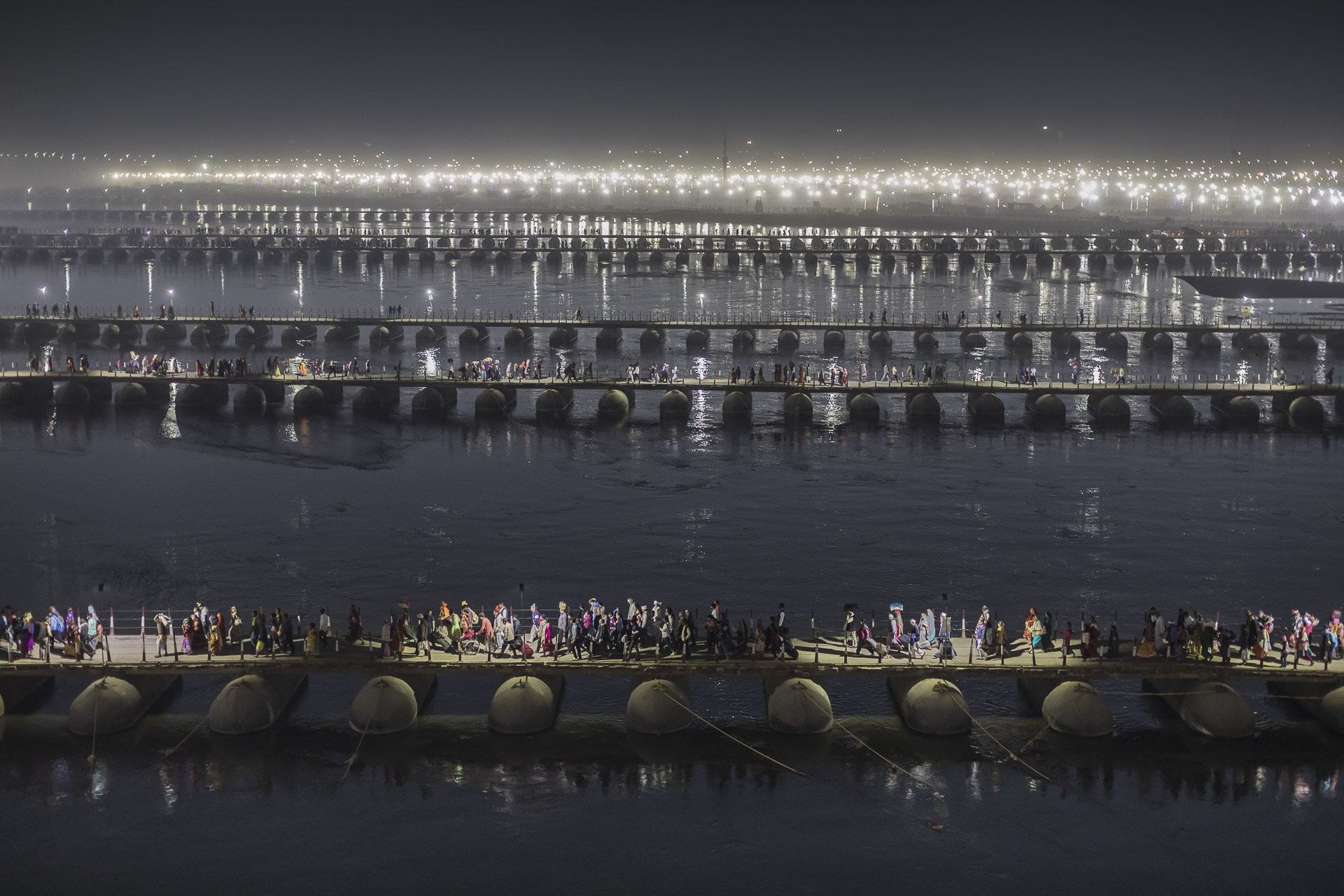
At night, tens of thousands of faithful cross temporary bridges over the Ganges River in Prayagraj (Allahabad), Uttar Pradesh, India, during the 2019 Kumbh Mela, the largest religious gathering in the world.
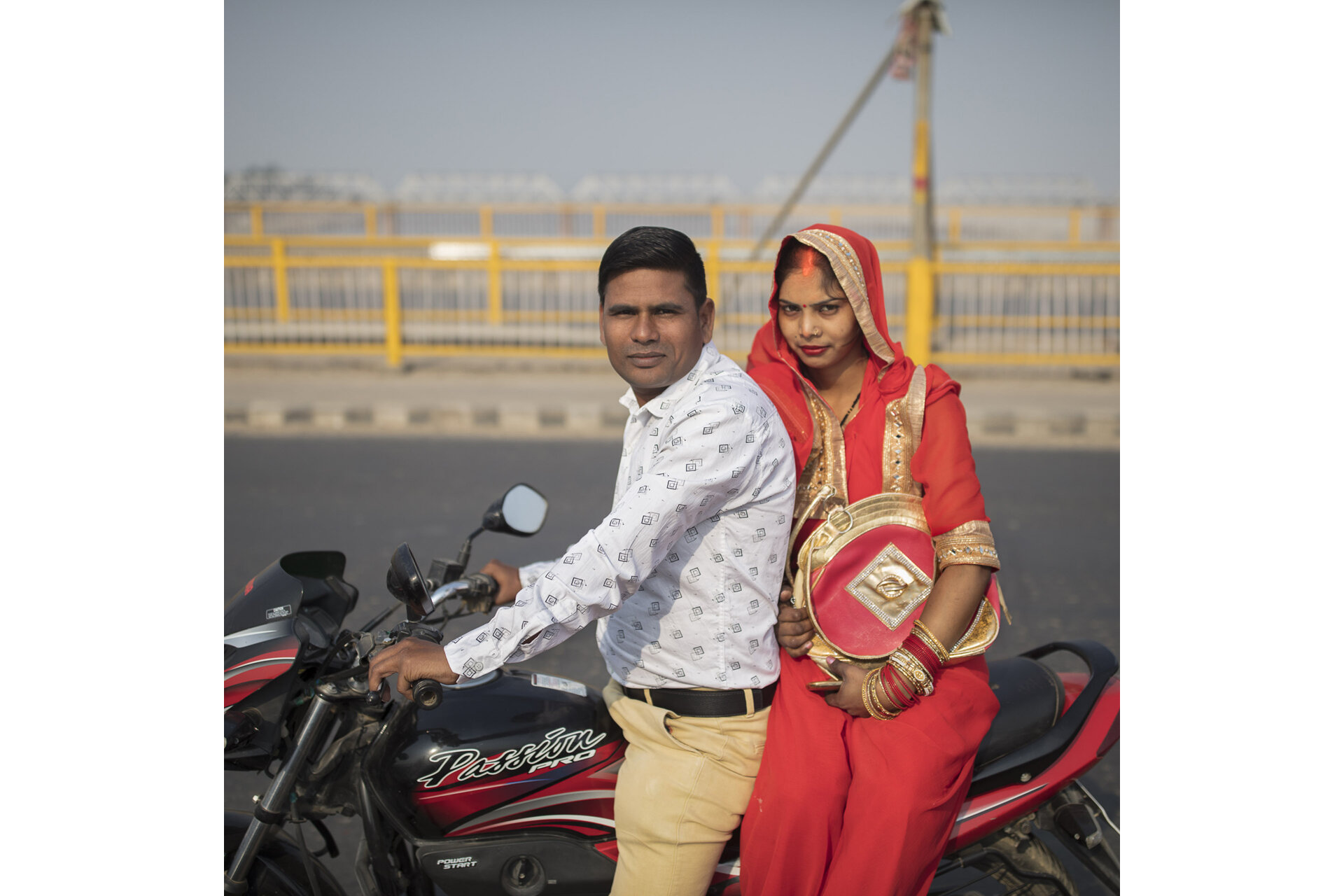
Roshanlan, 26, and his wife, Priyanka Devi, 22, couple portrait on motorbike in Prayagraj (Allahabad), India.

Village of blacksmiths in Chitrakoot, Uttar Pradesh, India. Members of the lower caste often due these more difficult unpleasant tasks, and as this group of nearly 100, are nomadic.
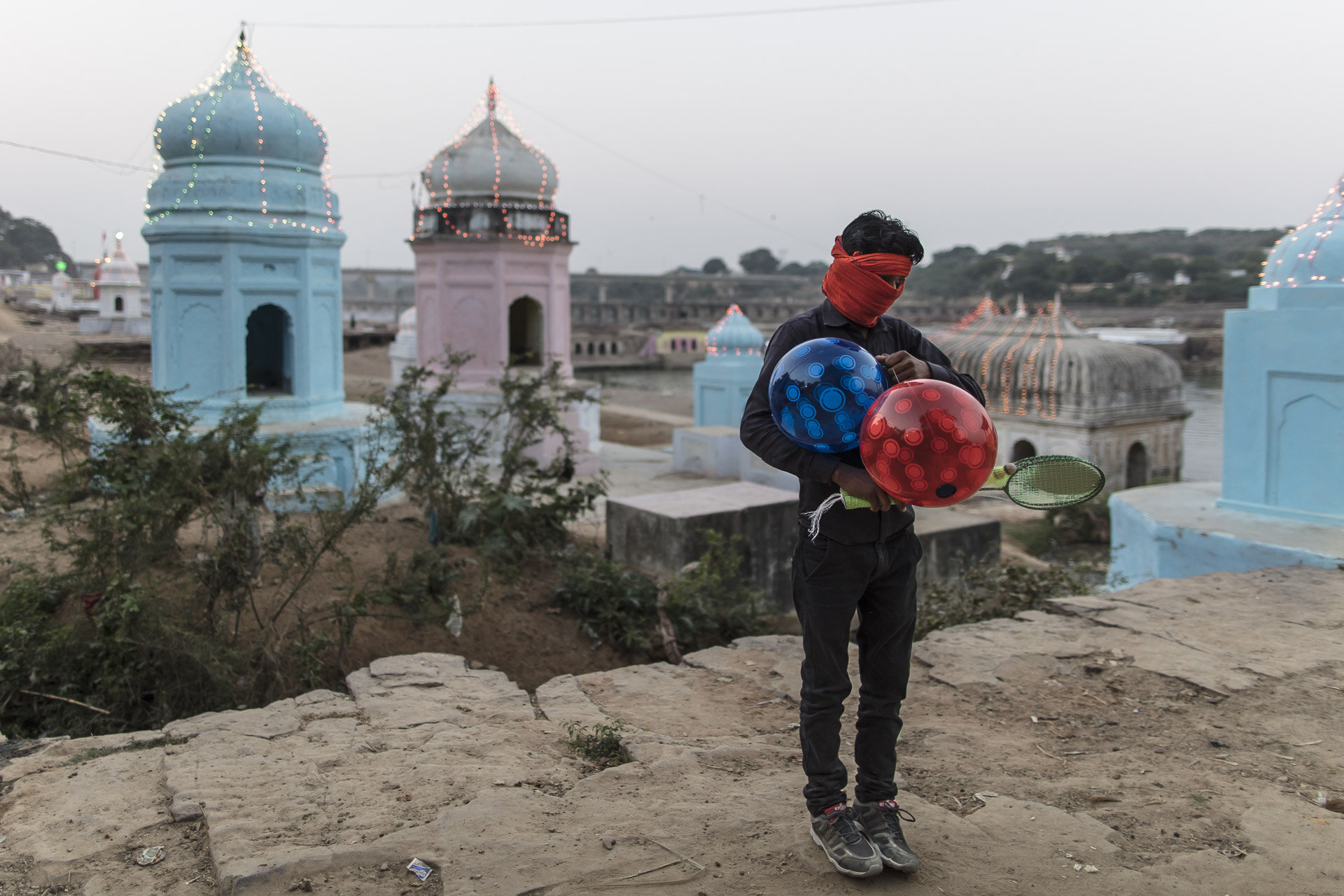
Portrait of a young man carrying balloons amongst the shrines to various Hindu deities along the banks of the Sindh River, part of the Shri Shanideva Maharaj Temple complex in Seondha, Madhya Pradesh, India. Like many rivers which are sacred in India, the Sindh River is heavily polluted.
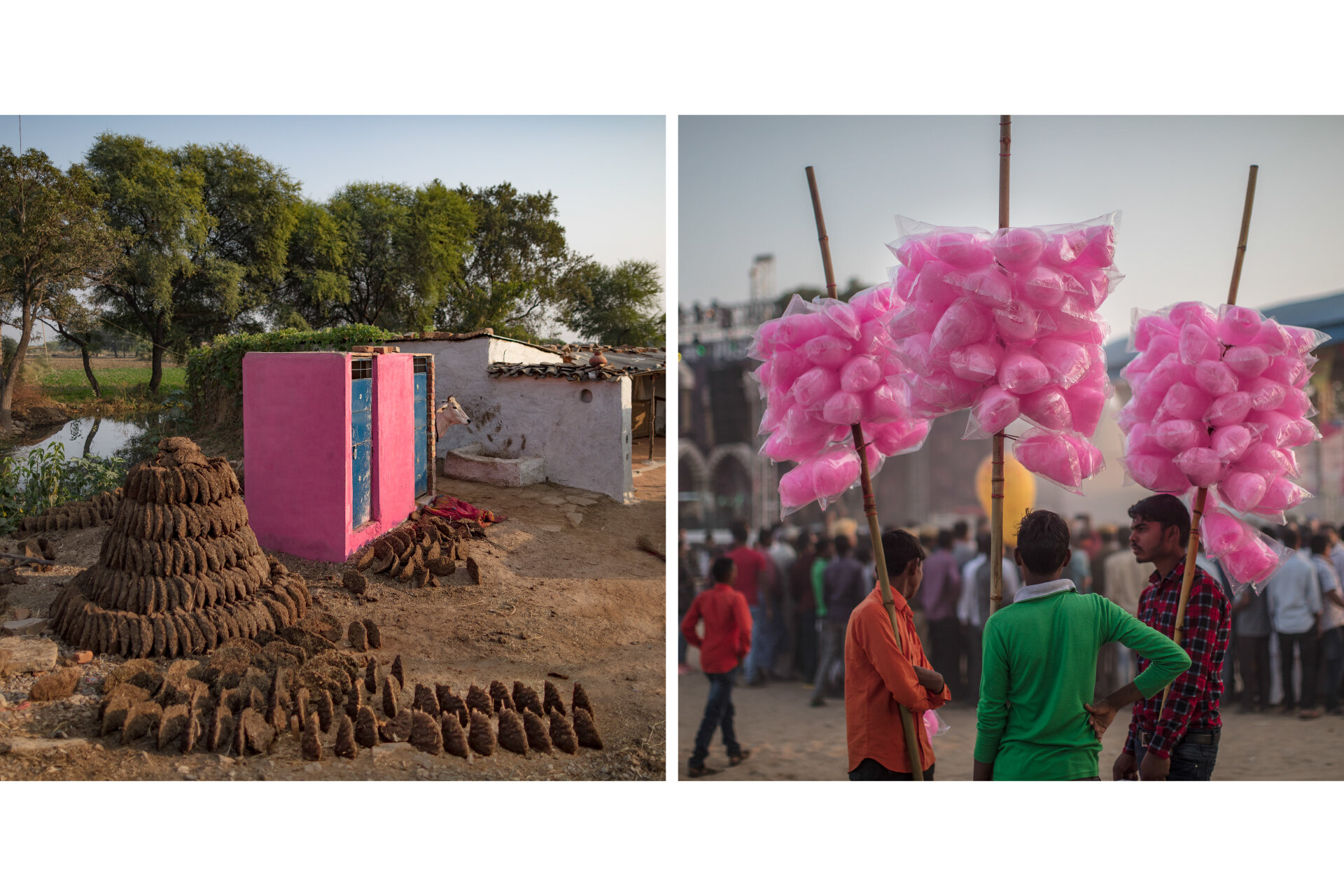
Cow, pink and blue structure, at a farmer's home where he sells cow patties to be used as fire for cooking and heating in Aswar Village near Madhya Pradesh. Cotton candy sellers at the Pushkar Camel Fair in Pushkar, Rajasthan.

Ragavendra, 27, barber along Bhind Amayan Road in Morsing Kapra, in Gramsalah village in Madhya Pradesh, India, cuts the hair of Gulag Singh, 32, at his roadside stall.
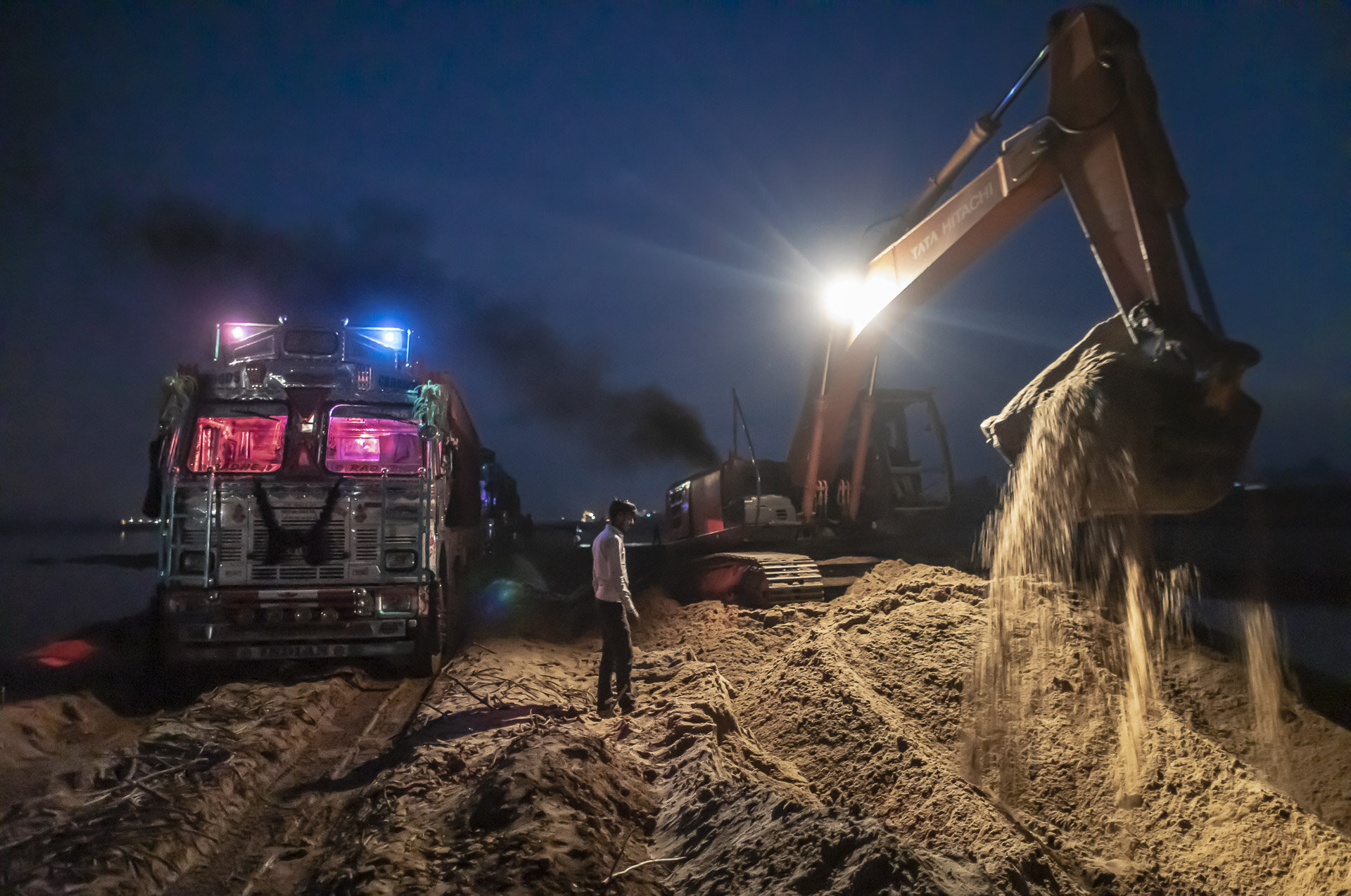
Working under the darkness of night with trucks and heavy machinery removes sand in illegal sand mining operations along the Sone River, a tributary of the Ganges River in Dheri, Sasaram, Bihar State. Sand mining is one of the greatest environmental crisis in India.

Lakhan Singh Sikrwal, 62, a former successful wrestler, he had his hands cut off and face disfigured by dacoits, a roaming gang who were unhappy with his success, that attacked him after a match when 21 years old. Today he runs a small roadside chai store in Takpura village in Madhya Pradesh.
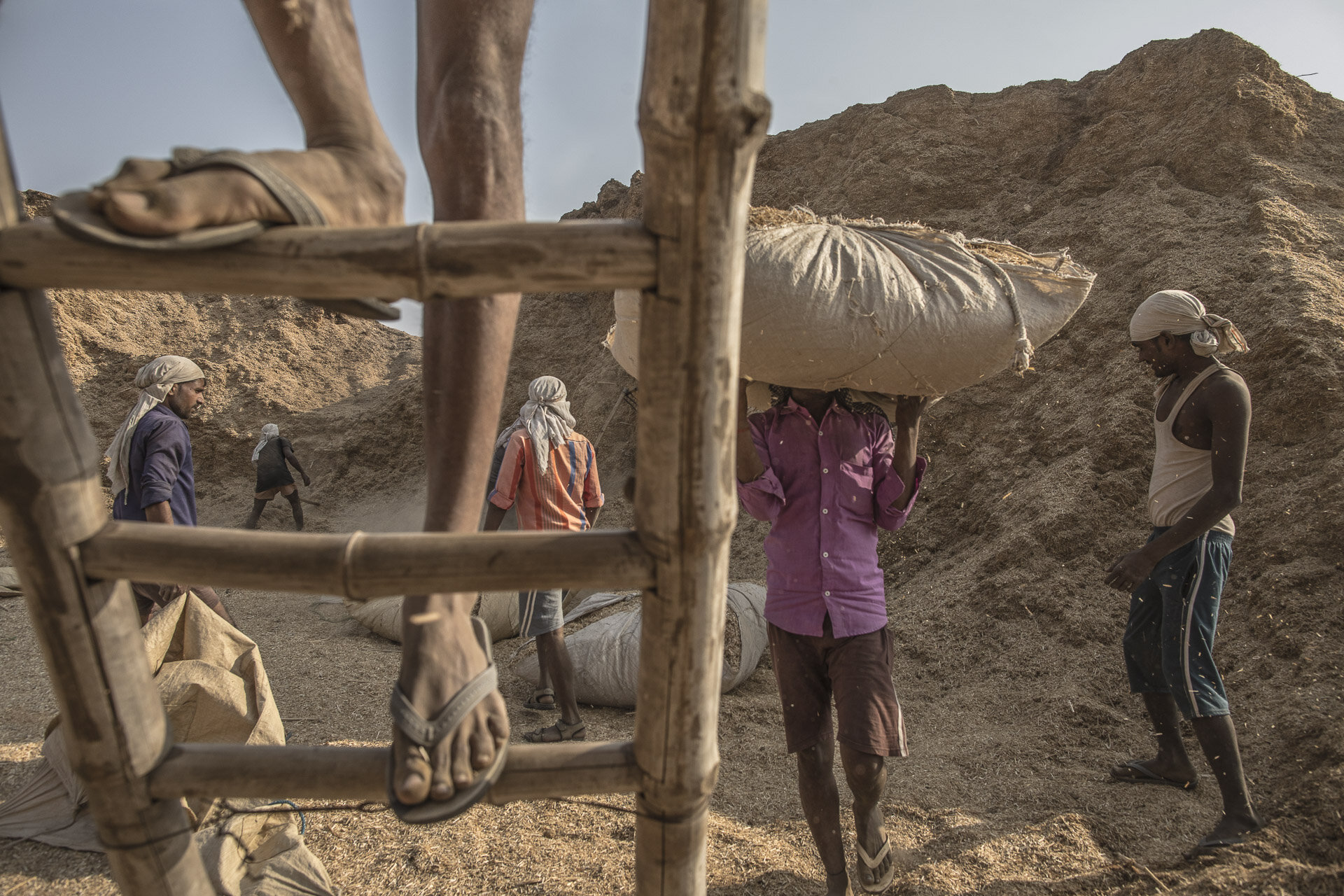
Remains of the mustard plant, Toori or hay material in Hindi, hoisted by low paid laborers in Guthor village in Sidh Dharam Kata located in Megaon Post Bhind District in Madhya Pradesh. This plant material will be used to burn in the brick-making industry throughout India.

Buddhist monks prayer around the Mahabodhi temple, built under the Gupta Empire, 6th century CE in Bodh Gaya, Buddha attained enlightenment beneath a sacred Bodhi Tree.
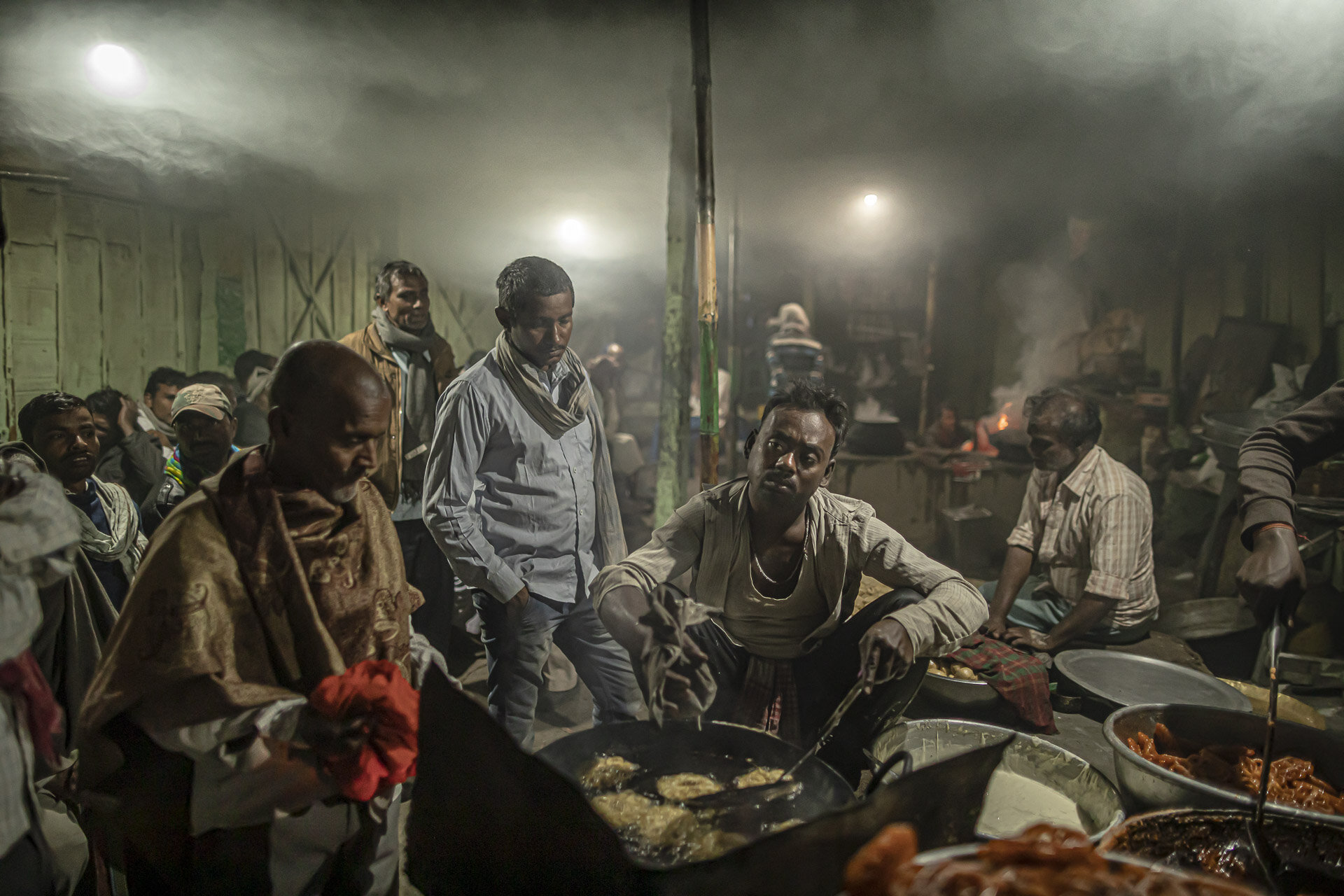
Smoke from a wood-burning stove swirls in the ceiling of a crowded restaurant, known as a dhaba, in the Bhagalpur, India.

Overcrowded buses, cars, and rickshaws in Naugachia, Bihar State, India.
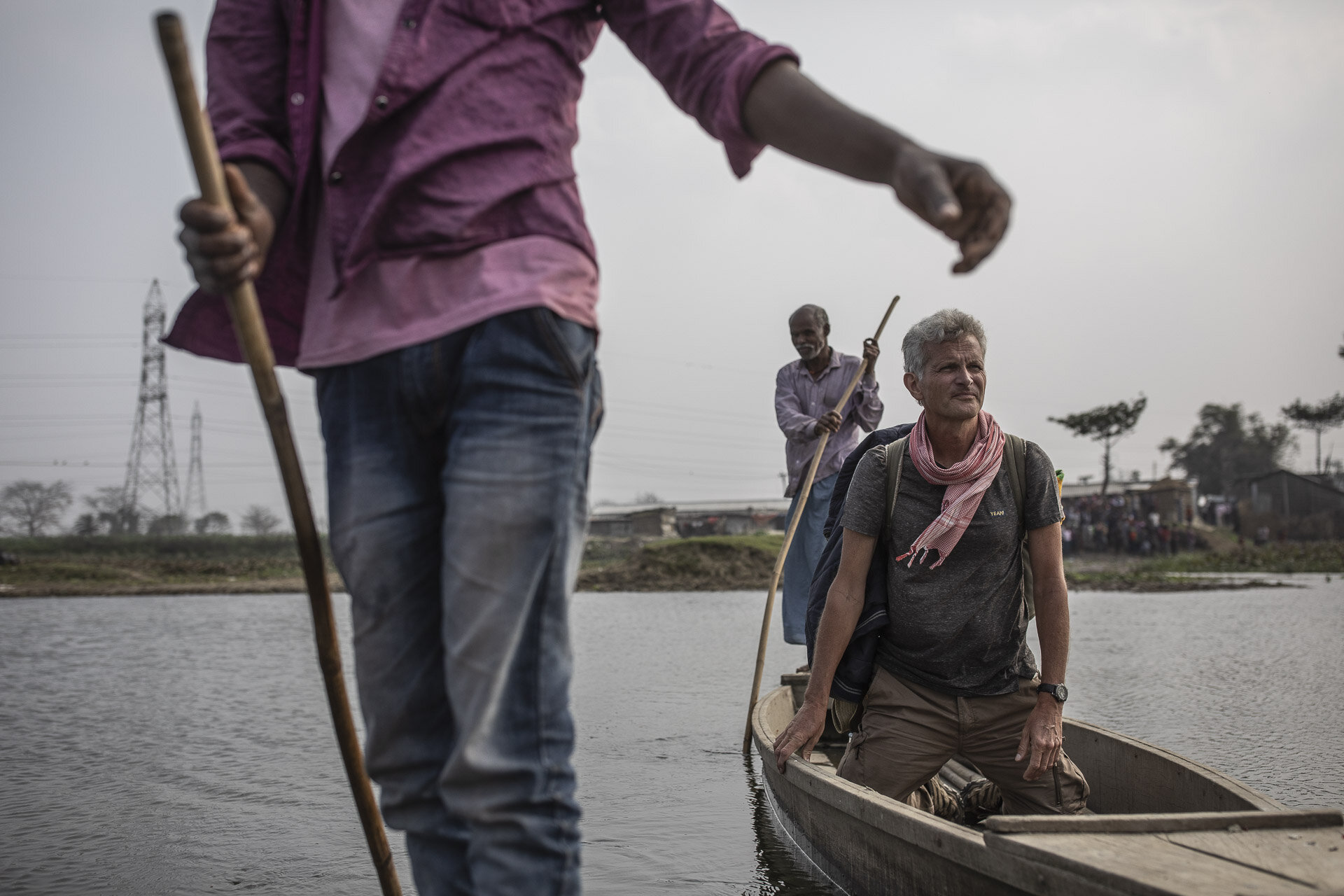
Paul Salopek takes a small boat with a boatman across a boy of water, the most direct path between Purnia and Lalganj, while walking through Bihar State, India. At this point in the Out of Eden Walk, Paul had journeyed by foot from Herto Buri, Ethiopia, more than 6500 miles and over 2200 days of walking.

Paul Salopek writing at night inside a blue lit Dhaba or Indian roadside restaurant in Purnia, Bihar State, India. Paul spent that night in this Dhaba, a common happening where people, including small businesses, welcome him to stay overnight.

Pinky and her future husband, Amit, have their pre-wedding photos taken by local photographers along the polluted Teesta River in West Bengal. Hindu offers lay scattered in the Sahu River in Nepali Basthi, also in West Bengal. Pollution left over from religious ceremonies are a major water pollution problem throughout all of India.
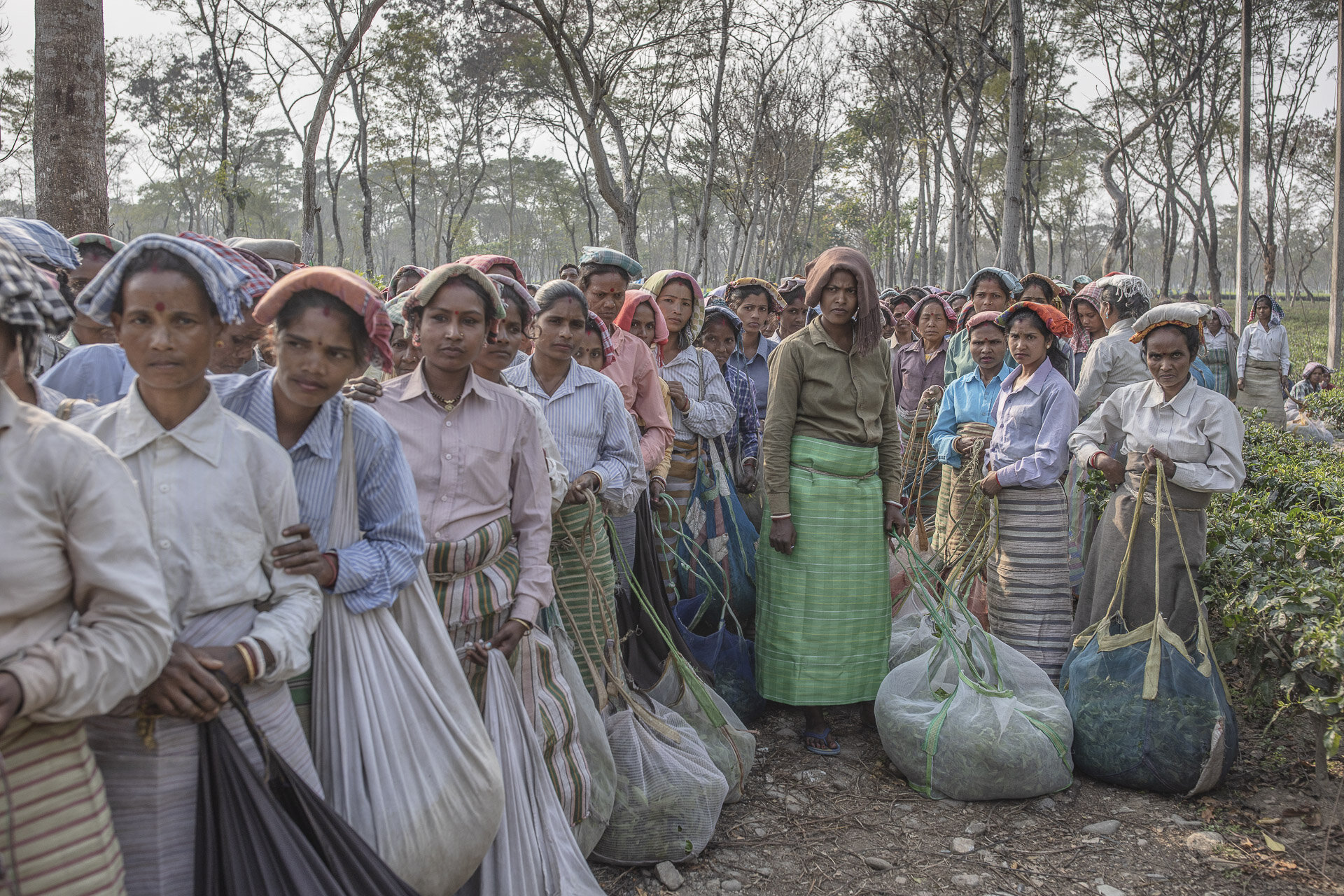
Hundreds of tea pluckers, all women, wait to weigh freshly picked tea leaves at the Looksan Tea Estate, in Looksan, West Bengal, India, one of the largest in the state. Each plucker earns roughly 172 rupees ($2.40 USD) per day or 3000 rupees ($42 USD) a month with bonus payments during the month of March for the first blush of tea leaves.

Tea pluckers pick tea leaves at the Looksan Tea Estate, in Looksan, West Bengal, India, one of the largest in the state. While the labor is long hours with low pay, the owner of Looksan Tea Estate’s treats their employees well, with no mention of abuse by the workers. Other tea plantations in India are not as well run, with cases of abuse.
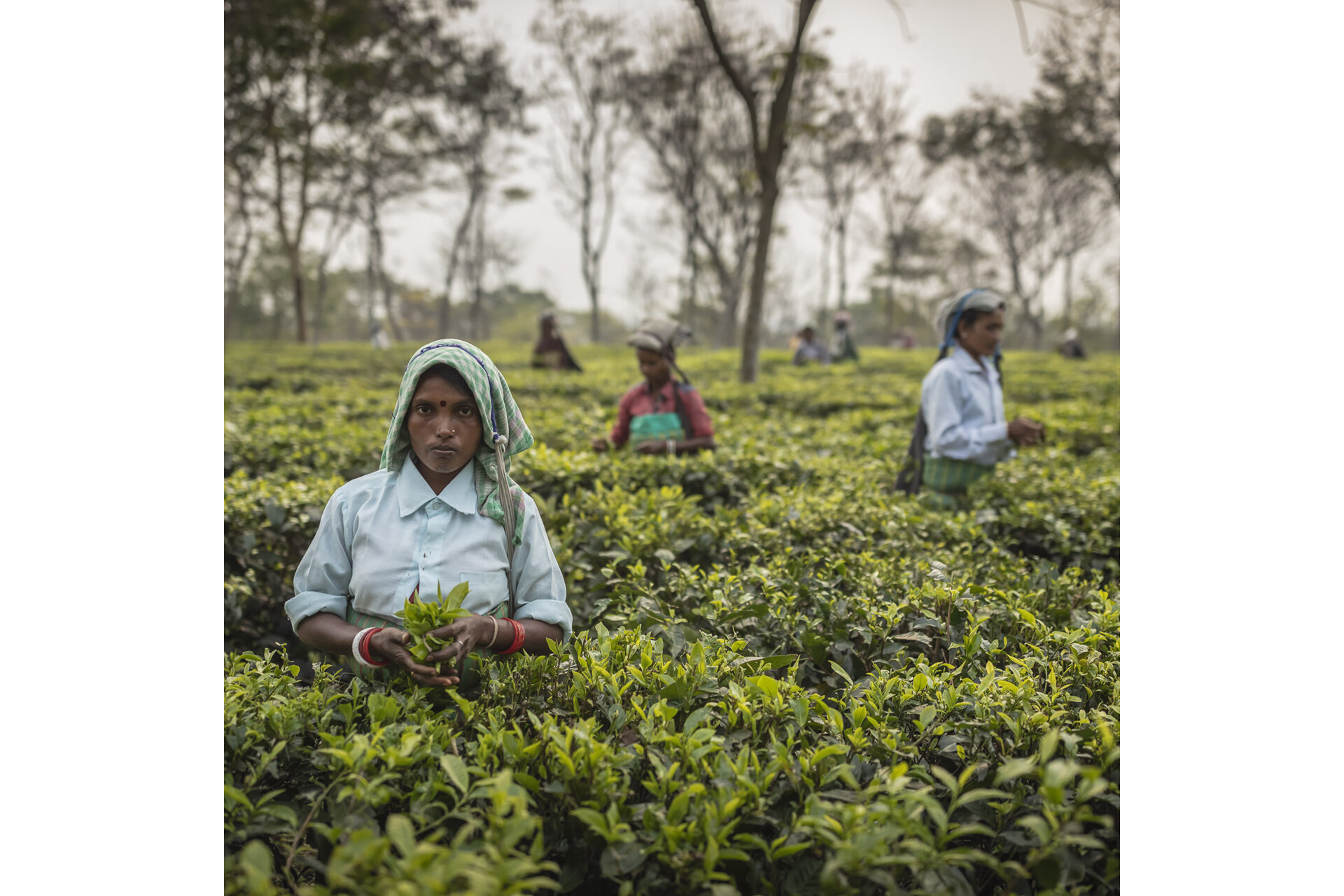
Early morning plucking tea leaves at the Looksan Tea Estate, in Looksan, West Bengal, India, one of the largest in the state.
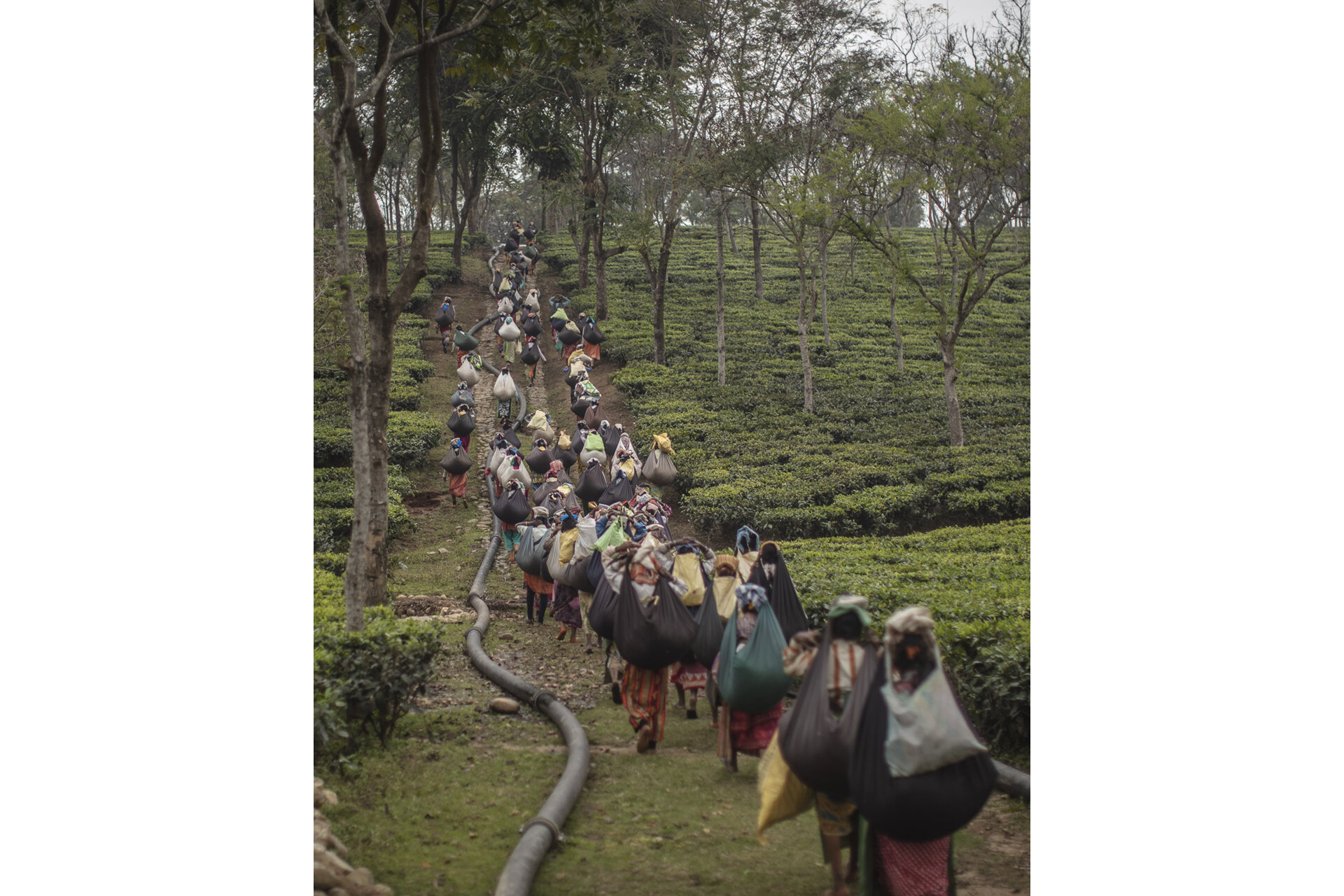
Carrying plucked tea leaves to be weighted at the Looksan Tea Estate, in Looksan, West Bengal.
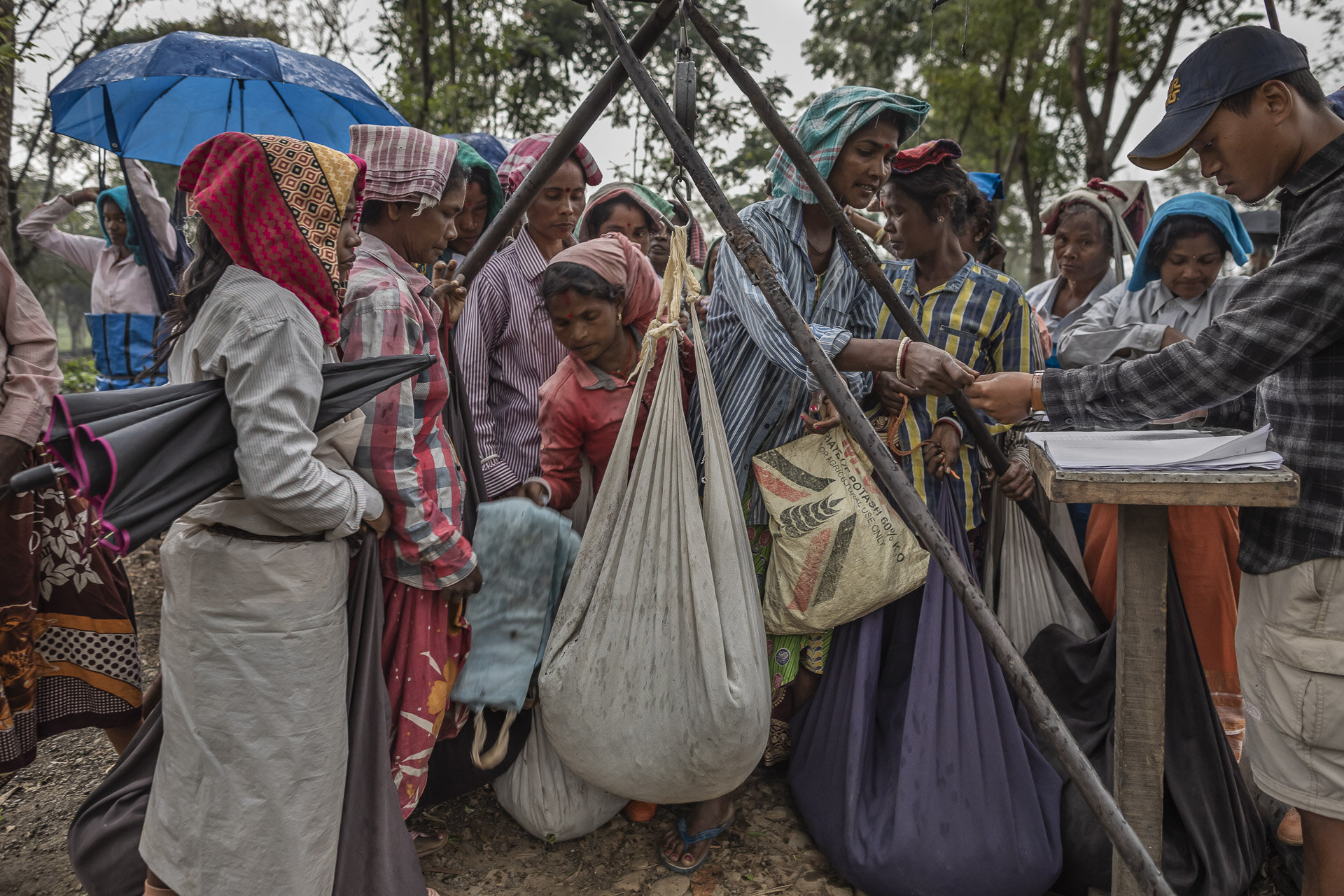
Weighing tea leaves at the Looksan Tea Estate, in Looksan, West Bengal.

Ferry terminal in Dhubri along the banks of the Brahmaputra river, Assam state, India. Many who work in this busy riverside town commute from remote villages on ferry boats.
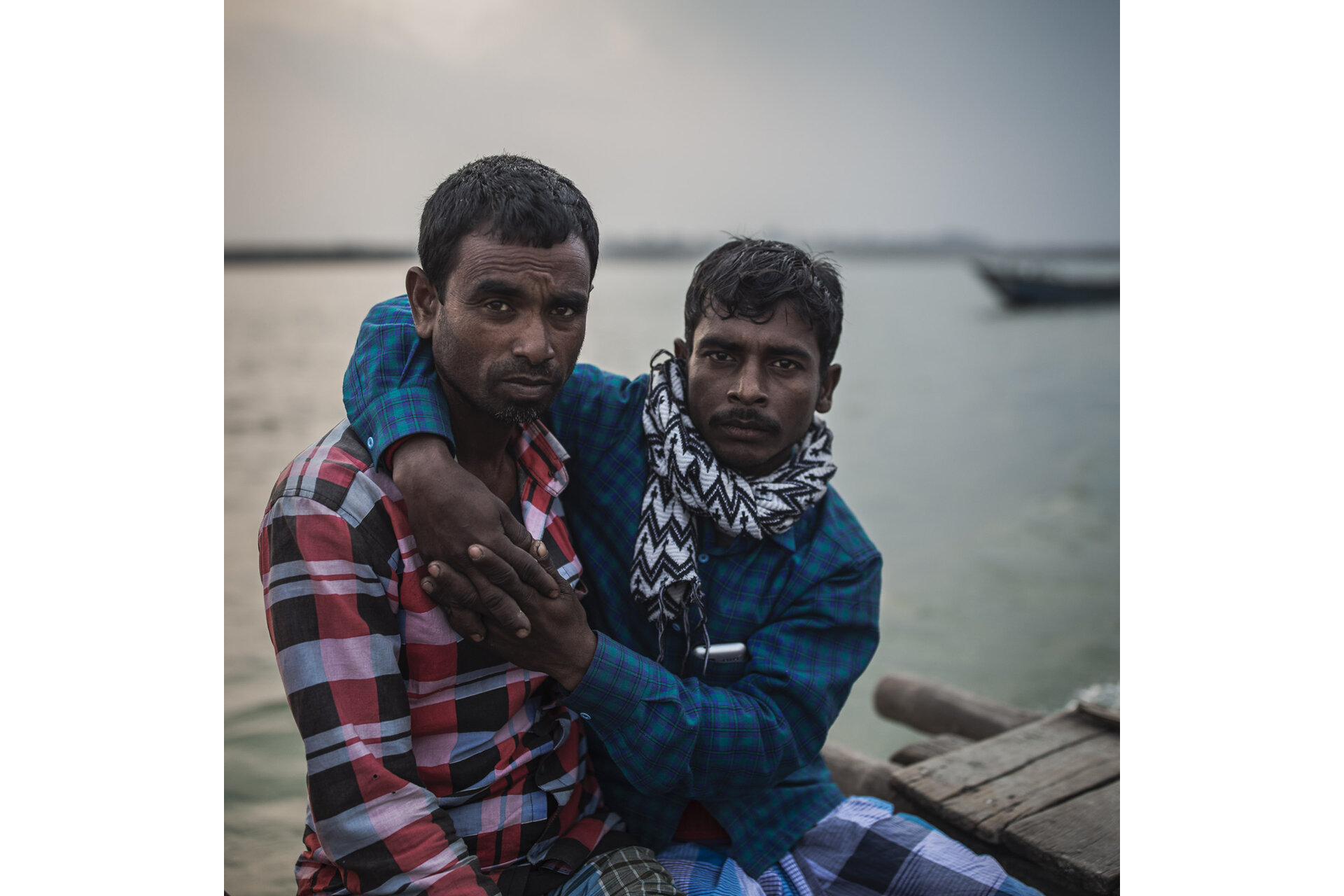
Passengers on a ferry boat along the Brahmaputra river, Assam state, India, after leaving the town of Dhubri. Many who work in the busy riverside town of Dhubri commute from remote villages on ferry boats.

Passengers disembark a ferry boat along the Brahmaputra river, Assam state, India, to the shoreline of Gauripur village, after leaving the town of Dhubri. Many who work in the busy riverside town of Dhubri commute from remote villages on ferry boats.
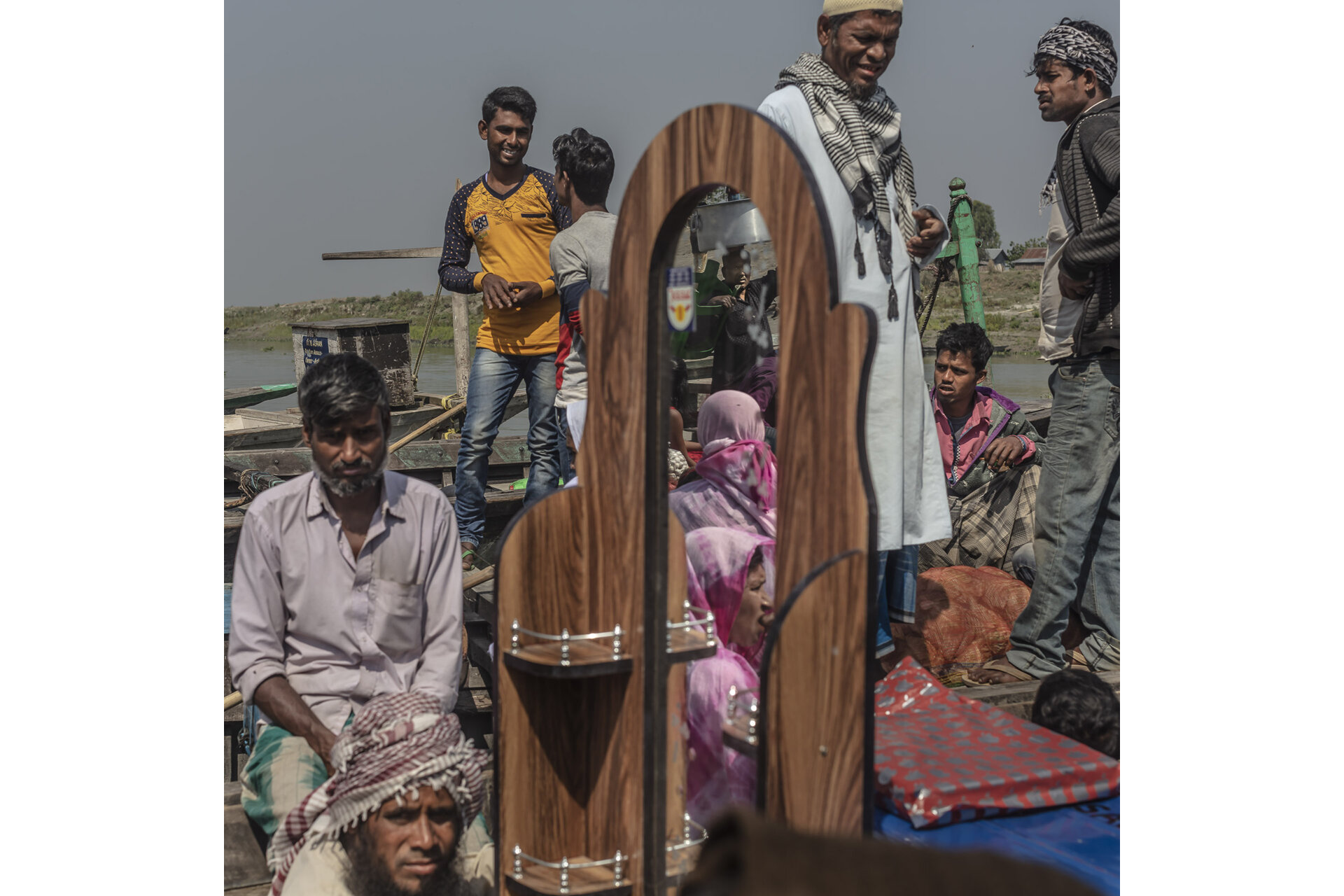
Passengers packed together with household items wait till to be transported by ferry boat in Dhubri to their remote villages along the Brahmaputra river, Assam State, India.

Powerful young girls outside their classroom at the Dhubri Girls’ Academy High School in Dhubri, Assam state, India. The empowerment of women throughout all of us India is crucial for economic growth and equality. The school was established in 1968.

Laborers carry heavy boxes of food and other supplies from the shore in Dhubri to boats that will take the product from the main city into remote villages along the Brahmaputra river, Assam state, India.
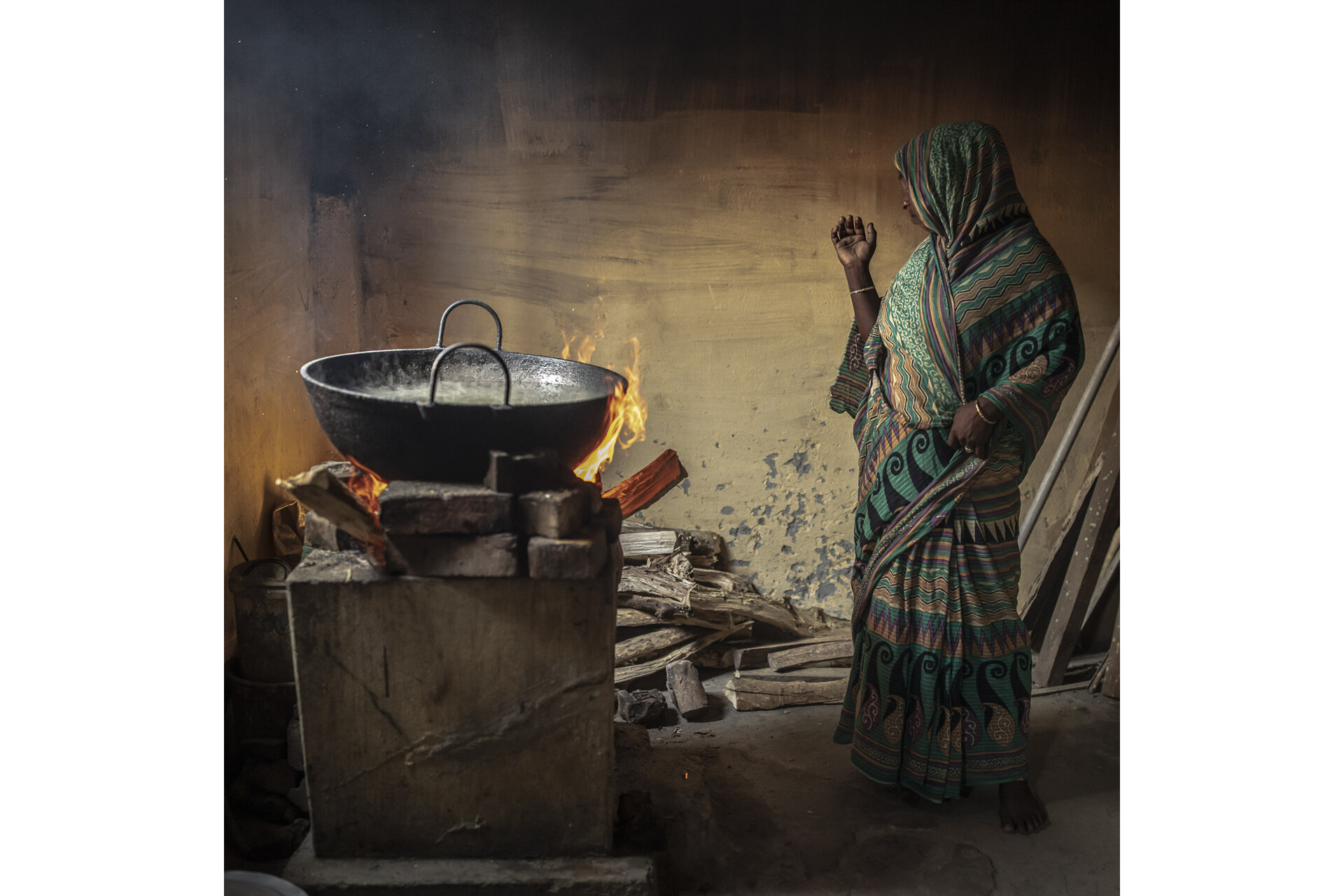
Shohitun Bibi, 50, preparing to cook kichidi in the kitchen of the Dhubri Girls’ Academy High School in Dhubri, Assam state, India.

Women carrying 35 kilograms (77 pounds) of bricks upon their heads at the Assam Brick Company on the outskirts of Dhubri in Assam State, India. These strong ladies carry such loads 100-200 a day, receiving $.019 cents per 35kg or around $2-4 per day. Millions of women across India work in such extreme labor.

A woman washing laundry on the Brahmaputra river along the shoreline that continues to erode on Majuli Island in Assam state, northeast India, to help stop erosion along the Brahmaputra river.

Rajib Kutum, 35, in Upar Chumaimari village on Majuli Island in Assam, India, pumps all the water out of his fishpond to collect the fish he’s been fish farming during the offseason of monsoons. An agricultural farmer and a fish farmer, Rajib loses his fish farm when the monsoon season arrives, where all the land is covered by the rising waters of the Brahmaputra river.

The future of India, powerful young girls in class at the Dhubri Girls’ Academy High School in Dhubri, Assam state, India. The empowerment of women throughout all of us India is crucial for economic growth and equality. The school was established in 1968.